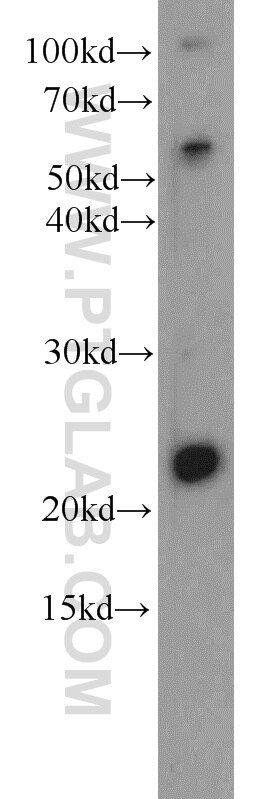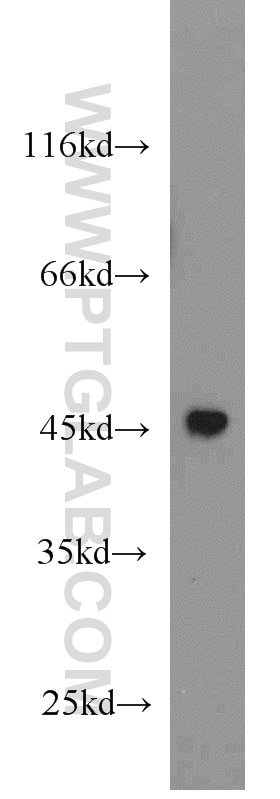Dermatopontin Polyklonaler Antikörper
Dermatopontin Polyklonal Antikörper für WB,ELISA
Wirt / Isotyp
Kaninchen / IgG
Getestete Reaktivität
human, Maus, Ratte
Anwendung
WB,ELISA
Konjugation
Unkonjugiert
Kat-Nr. : 14777-1-AP
Synonyme
Galerie der Validierungsdaten
Geprüfte Anwendungen
| Erfolgreiche Detektion in WB | Rattenhautgewebe |
Empfohlene Verdünnung
| Anwendung | Verdünnung |
|---|---|
| Western Blot (WB) | WB : 1:500-1:2000 |
| It is recommended that this reagent should be titrated in each testing system to obtain optimal results. | |
| Sample-dependent, check data in validation data gallery | |
Produktinformation
14777-1-AP bindet in WB,ELISA Dermatopontin und zeigt Reaktivität mit human, Maus, Ratten
| Getestete Reaktivität | human, Maus, Ratte |
| Wirt / Isotyp | Kaninchen / IgG |
| Klonalität | Polyklonal |
| Typ | Antikörper |
| Immunogen | Dermatopontin fusion protein Ag6200 |
| Vollständiger Name | dermatopontin |
| Berechnetes Molekulargewicht | 22 kDa |
| Beobachtetes Molekulargewicht | 22 kDa |
| GenBank-Zugangsnummer | BC033736 |
| Gene symbol | DPT |
| Gene ID (NCBI) | 1805 |
| Konjugation | Unkonjugiert |
| Form | Liquid |
| Reinigungsmethode | Antigen-Affinitätsreinigung |
| Lagerungspuffer | PBS mit 0.02% Natriumazid und 50% Glycerin pH 7.3. |
| Lagerungsbedingungen | Bei -20°C lagern. Nach dem Versand ein Jahr lang stabil Aliquotieren ist bei -20oC Lagerung nicht notwendig. 20ul Größen enthalten 0,1% BSA. |
Hintergrundinformationen
DPT (dermatopontin) is an extracellular matrix protein belonging to the dermatopontin family. Skin appears to be the richest source of dermatopontin, comprising about 15 mg/kg of the wet weight. Expression of dermatopontin is not limited to connective tissue, as investigations show that dermatopontin mRNA is expressed in cultured fibroblasts, muscle, heart, pancreas, and lung. Dermatopontin comprises a considerable proportion of the noncollagenous extracellular matrix proteins. It is involved in promotion of cellular adhesion, extracellular matrix assembly and wound healing.
Protokolle
| Produktspezifische Protokolle | |
|---|---|
| WB protocol for Dermatopontin antibody 14777-1-AP | Protokoll herunterladen |
| Standard-Protokolle | |
|---|---|
| Klicken Sie hier, um unsere Standardprotokolle anzuzeigen |











